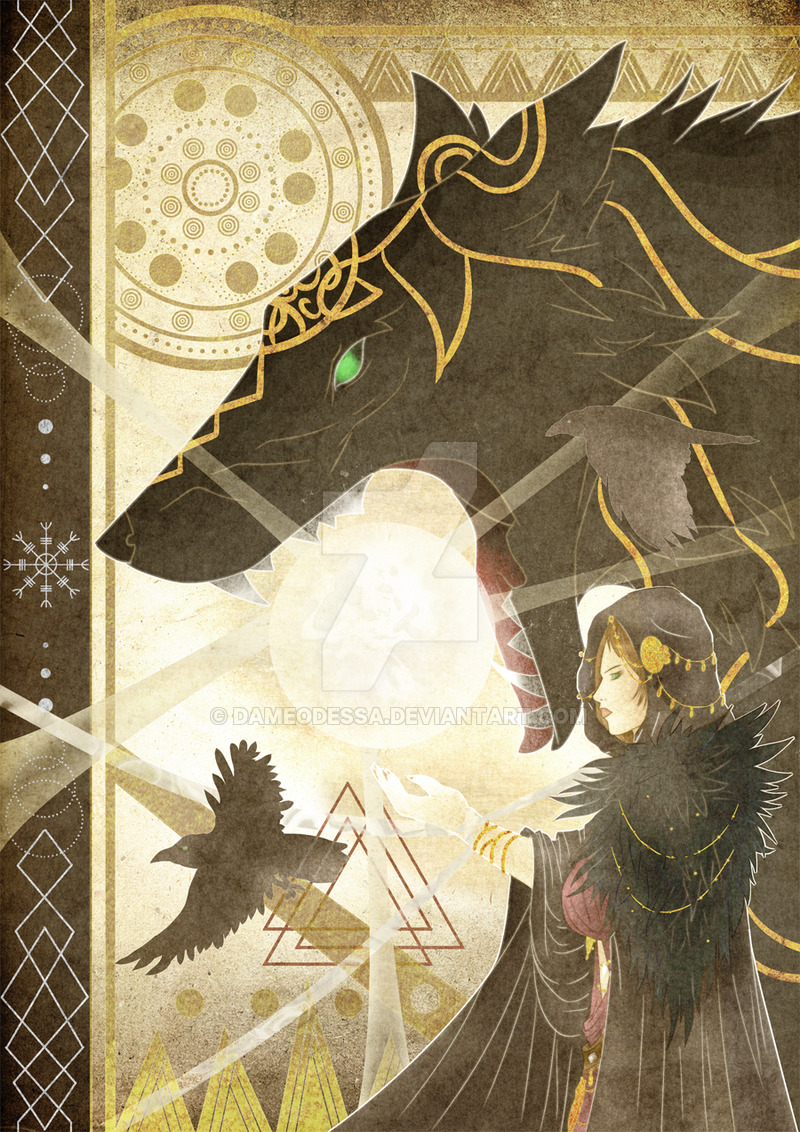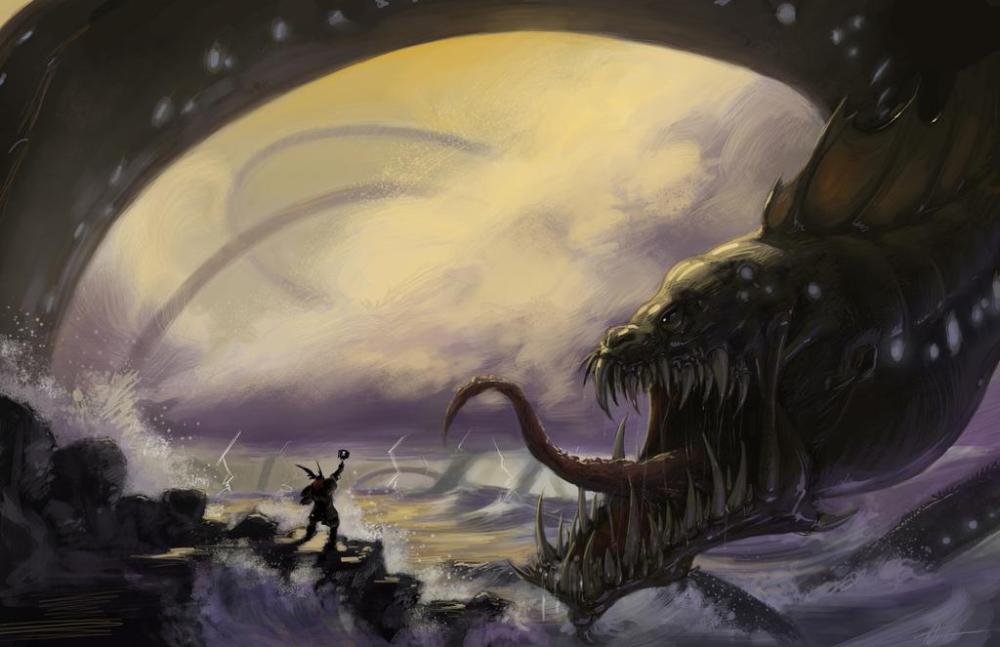What exactly the values of Rökkatru are tend to be defined by how people understand and experience the Rökkr themselves, and yet there are general ideas about what these values are that seem to be more or less agreed upon. What this means is that Rökkatru read and analyze the lore, and take what they learn from this together with what they’ve learned from their personal spiritual experiences with the Rökkr, as well as common shared personal gnosis, to form an idea of what value or “lesson” each entity in the Rökkr pantheon teaches.
This is part of the reason why defining the pantheon itself—who is included and who isn’t—is an important question. Regardless of whether or not that question has been properly answered (given that depending on who you ask some entities may or may not on the list of Rökkr), we can look at the values that individual Rökkr are generally considered to teach, especially the ones that have been written of. It is also feasible from this starting point to begin analyzing the lore around other entities whose values may not have been explored or defined yet, as well as meditating, journeying, and divining to learn more about these beings and what they represent.
Let’s begin first with those beings that are consistently counted among the Rökkr, and take a look at what their values are generally considered to be:
Loki is in many ways considered the “father” of the Rökkr pantheon, given that he fathered Fenrir, Hela, and Jörmungandr with Angrboda. It is his family that clearly makes up the core Rökkr pantheon, and as a result he holds a place of prominence and importance among to Rökkatru.
Though outside of the Rökkatru and Lokean communities Loki is often known as a liar due to his nature as a trickster, within the communities which hail him it is this very nature that lends to him being associated with the value of self-knowledge. Through his stories harsh truths are often faced or stated, often unwillingly. This isn’t something that Loki only does to others, as seen in Lokasenna. It is something that Loki often undergoes in the stories himself, when he is forced to own up to mistakes he’s made or tricks he’s played and fix them.
In addition to this, many Rökkatru and Lokeans describe a relationship with Loki that demands that they be honest with themselves. Honesty with the self is often described as being a precursor to being able to speak hard truths to others. For this reason, a lot of people will describe this value not as self-knowledge, but as self-truth or self-honesty.
Angrboda can be considered the “mother” of the Rökkr in the same way that Loki can be considered the father. In some ways she may considered as even more deeply rooted in the Rökkr pantheon than Loki: to the best of our knowledge she has never lived among the Æsir and her only tie to them is through Loki, who has made a home among them. She is jötunn through and through.
Very little is known about Angrboda from the lore. She is believed by many to be the volva from Voluspa and is known as the mother of Loki’s monstrous children, but there isn’t much else to go off of. She is a jötunn, however, and the lore makes very clear that the jötnar are an incredibly diverse lot: they are described in all manner of shapes, forms, and sizes. There doesn’t seem to be one single idea of what a jötunn must look like.
Beyond the little that we know from the lore, in modern practice many people associate Angrboda with strength and leadership, particularly in often being viewed as a powerful figure among the jötnar of the Ironwood. This is drawn not only from scholarly inferences and extrapolations (from mentions of an unnamed jötunn woman in Járnvid or the Ironwood in both Voluspa as well as Gylfaginning) but is also informed by Unverified Personal Gnosis (UPG) and Peer or Community Verified Personal Gnosis (PVPG / CVPG).
Due to this association not only of Angrboda as a mother of Rökkr but also as a chief or leader among the jötnar, she is strongly associated with diversity (recall how diverse in shape and form the jötnar are). It is due to this that her value is so often considered to be diversity, and unconditional acceptance of that diversity. On the Northern Tradition Paganism website it is stated that, “Being close to Nature, [the jötnar] understand that diversity is survival and strength, while homogeneity is inevitable weakness.” This is something we do see in nature: homogeneity is often related to genetic bottlenecks, which can be linked to weakened immunity and increases in genetic mishaps that result in overall negatively impacted health.
Given that the jötnar are so closely tied with nature and are represented so diversely, it only makes sense that they should be associated with diversity and the strength. Because Angrboda is often recognized as a very prominent jötnar, it is equally logical that she should be seen as carrying that value of diversity.
I might add that values of acceptance and community would be closely tied with that of diversity, not only because of how we see these three values interconnecting in our world but also because of Angrboda’s assumed position within a community of such diverse entities that are welcomed and accepted no matter their shape, color, or presentatation.
Fenrir is perhaps the most demonized and disdained of Angrboda and Loki’s children. A monstrously sized wolf, he is prophesied to devour Odin at Ragnarok, and otherwise wreak havoc and destruction at this time. It is for this reason that he is bound by the Æsir, during which Tyr sacrificed his hand to Fenrir as a means of gaining Fenrir’s cooperation in their “game.”
Due to this prophecy, which is referred to several times throughout the Eddas, Fenrir is primarily associated with destruction and forces of destruction. This is sometimes generalized to include unbridled chaos and even rage or anger. As such, Fenrir is associated with all those things that we dislike, try to avoid, and in our own selves try to repress or cut out of ourselves.
Because of this Fenrir has become very closely associated with the concept of the shadow or shadow self. This concept originates with Jung’s archetypes, and, simply put, represents the idea that there are parts of ourselves that we want to shut away and not acknowledge, typically the parts of us that are not considered societally acceptable—the parts of ourselves that are violent, sexual, crude, vulgar.
So Fenrir’s value or rule has come to be shadow, or, more specifically, acknowledging and honoring the shadow. This is closely linked with Loki’s values, as one much first be honest with one’s self and know one’s self before they can truly learn to accept, be at peace with, work with, and honor your shadow.
Hela is the goddess of one of Heathenry’s underwolds/afterlives. She rules over Hel (the place with which she shares a name), the realm where those who die of old age, illness, etc. go to reside after death. (As an aside: Huginn’s Heathen Hoff has featured a lovely blog post about how the Heathen afterlife is much more complex than is often realized).
Obviously Hela is most strongly linked with death. In the lore her most prominent presence is in the myth of Baldr’s death, and beyond this there is little else recorded about her beside her notable appearance and her relationship to Angrboda and Loki.
Death’s vision is much different than that of life—it sees what may be overlooked or even unseeable by life, it sees farther than any life can stretch, and in itself is both a truly neutral and truly equalizing force. Think of the Rider Waite Death Card: even kings and popes must come to Death’s door eventually, just as must all others. Because of these factors, Hela’s value has come to be known as vision or perspective.
Jörmungandr is the giant serpent prophesied to kill Thor during Ragnarok, just as Fenrir is prophesied to kill Odin. The perpetual enemy of Thor and child of Angrboda and Loki, Jörmungandr was said to live in the oceans of Midgard (our world) and to have grown so long that his body could coil around the earth.
Jörmungandr is a creature of the in-between, born of Jötunheim but cast to Midgard. The serpent is also felt by some (in UPG/PVPG) to be of ambiguous gender. Snakes have also historically often been associated with death and rebirth due to the shedding of their skins—things which live on the edge of human consciousness and are associated with transition.
These things lend well to defining Jörmungandr’s as liminality. Liminal times and places are often associated with great spiritual and magical power in many European traditions. Translated into more mundane times and places, when humans find themselves in spaces that are liminal they often also find that they places are horribly uncomfortable—and can be periods of some of our most intense growth, depending upon the individuals and circumstances involved. The value of liminality here may be a reminder that these difficult and uncomfortable spaces can be acknowledged, accepted, and valued, respected, and even productively worked with, much in the way that Fenrir reminds us to approach the shadow.



Beautifully said. Thank you, can’t wait to see the following parts.
LikeLiked by 1 person